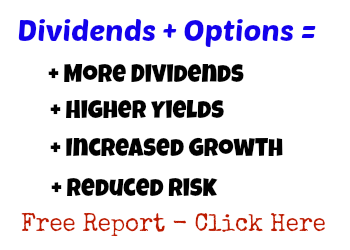Calculating Dividends
Calculating dividends is fairly straightforward, although there are different categories and metrics involved.
Note: all references below assume that the dividend yielding stock in question distributes quarterly.
The following is a quick guide to calculating dividends in terms of:
- Total Payments - To calculate dividends in terms of total dollars, simply take the number of shares you own and multiply it by the dividend declared per share.
For example, if you own 100 shares of a dividend yielding stock that pays a $0.25 quarterly dividend (per share), your total payout will be $25 every three months, or $100 per year.
- Current Yield - Current stock dividend yields are based on the most recent quarterly distributions (or upcoming distributions once those have been announced) and then projected on an annualized basis. This number represents what percentage returns in the form of cash dividends an investor would receive when purchasing the dividend yielding stock at the current price.
To calculate a stock's current yield, take the most recent quarter's per share distribution and multiply it by four. that represents the projected annualized payout. Take that number and divide it by the current share price. The result is the stock's current (annualized) yield.
- Effective Yield - I love calculating dividends in terms of effective yield. What happens when a company raises its dividends on stock you already own? If the share price rises, the current yield might stay the same (for new investors) as the share price rises, but your effective yield, based on your original investment, increases. This is the basis of dividend growth investing.
For example, if you purchase a stock with a current yield of 3% and one year later, the company announces a dividend increase of 10%, your effective yield jumps to 3.3%. That may not sound like much at first, but over time, the compounding effects can be profound.
For more a more detailed discussion, see the related site article, High Dividend Stocks and Option Trading.
- Adjusted Yield (Leveraged Investing) - There's one other form of dividend yield you probably won't find mentioned anywhere else. I call it Adjusted Yield, and it's a component of my Leveraged Investing approach to long term investing.
It's similar to effective yield, but it works a little bit in reverse. Your effective yield increases as a company's dividend increases. But your Adjusted Yield increases when your original cost basis is adjusted lower through certain strategic and conservative option trading strategies.
Combining effective yield (dividend growth) with adjusted yield (perpetually reducing your cost basis) on high quality companies is without a doubt the most powerful and effective way to invest that I know of.
Tweet
Follow @LeveragedInvest
Related Articles and Resources:
Create Your Own Dividend Reinvestment Program
Dividend Reinvestment Plans: A Leveraged Investing Alternative
High Dividend Stocks and Option Trading
Dividend Growth Investing: Why It's Superior To Growth Investing

>> The Complete Guide to Selling Puts (Best Put Selling Resource on the Web)
>> Constructing Multiple Lines of Defense Into Your Put Selling Trades (How to Safely Sell Options for High Yield Income in Any Market Environment)
Option Trading and Duration Series
Part 1 >> Best Durations When Buying or Selling Options (Updated Article)
Part 2 >> The Sweet Spot Expiration Date When Selling Options
Part 3 >> Pros and Cons of Selling Weekly Options
>> Comprehensive Guide to Selling Puts on Margin
Selling Puts and Earnings Series
>> Why Bear Markets Don't Matter When You Own a Great Business (Updated Article)
Part 1 >> Selling Puts Into Earnings
Part 2 >> How to Use Earnings to Manage and Repair a Short Put Trade
Part 3 >> Selling Puts and the Earnings Calendar (Weird but Important Tip)
Mastering the Psychology of the Stock Market Series
Part 1 >> Myth of Efficient Market Hypothesis
Part 2 >> Myth of Smart Money
Part 3 >> Psychology of Secular Bull and Bear Markets
Part 4 >> How to Know When a Stock Bubble is About to Pop



